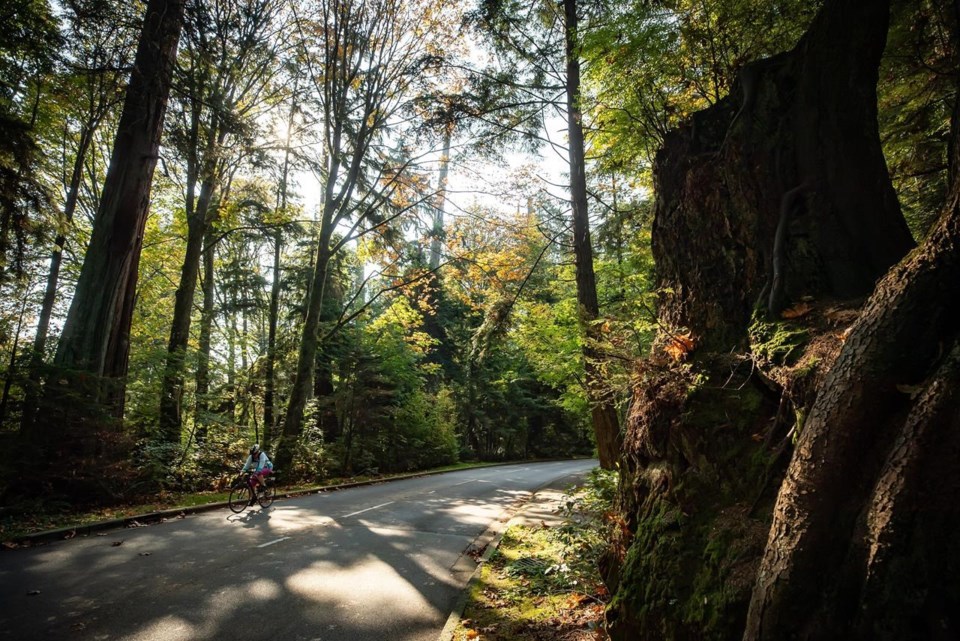VANCOUVER — The quiet of Stanley Park’s forests has been splintered as chainsaws roar in a multi-year project to remove about one quarter of the trees that make up what's considered a Vancouver jewel.
On the road to Prospect Point a parking lot that in warmer months would be part of a picnic area, is now a work site where heavy machinery brings in large, cut sections of trees and crushes smaller branches.
They are among the first of what's expected to be 160,000 trees removed for public safety reasons after a years-long infestation of western hemlock looper moths.
“Removing trees is not something we take lightly, but this work is essential to restarting the forest afresh and giving it the strongest chance at withstanding future threats to its health,” Amit Gandha, director of parks at the Vancouver Board of Parks and Recreation, said in a statement.
The juvenile form of the moth, a member of the inchworm family, chews on both the fresh, green needles of trees in the spring as well as older needles, said Allan Carroll, director of the University of British Columbia's forest sciences program.
"So, the result is that trees can be completely defoliated just in two or three years," he said.
"And if the trees lose all their needles, they can't regrow them, and they die. And that's where the impact of a looper comes in."
No one from either the city or Vancouver's park board was available for an interview about the park's losses.
City spokeswoman Eva Cook said in a statement that 140,000 of the trees to be chopped are less than 20 cm in diameter and the vast majority are hemlock — the moth's preferred food source.
"These are younger trees that are dead and brown, and will contribute to wildfire surface fuel if left in place," Cook said.
"The remaining 20,000 dead trees are larger than 20 cm in diameter and must be removed in support of public safety and to protect infrastructure in and around Stanley Park."
Carroll said outbreaks of the moths, which are native to the area, are a normal part of a forest's ecosystem.
"Certainly people don't like the idea of change, especially when it comes to a jewel like Stanley Park, but unfortunately, forests are not static. They change and they change oftentimes by these sort of disturbance processes."
He said conversations around whether to try and stop an infestation of a native species, or let it run its course, are complicated ones.
Provincial and national parks are mandated not to step in because such disturbances are seen as natural and necessary process, he said.
In the case of Stanley Park, it would have been up to local officials to decide if they wanted to go that route or try and make the park more static in the name of activities like trail walking and weddings.
"I have no answer for that, and nor should I, as a scientist. It's something that the park managers had to decide," he said.
"And in this particular case, I guess they decided to let the hemlock looper be the hemlock looper and do to the park what it would do normally. And now they're just faced with mopping up afterwards."
The board said in its statement that areas where trees have been lost will be replanted with tens of thousands of native species, including Douglas fir, western red cedar, grand fir, big leaf maple and red alder, with the long-term goal to "reset the ecology" of Stanley Park.
Carroll said the park's infestation is essentially over, now that the moths have killed off their food source, and planting those species of trees mirrors what would likely replace them in the natural environment.
Karen Soyka, vice-president of strategy and business development for the tourism group Destination Vancouver, said Stanley Park helps draw millions to the city.
She said she trusts that the decision to take down the trees was made with Vancouver's best interests in mind.
"Whatever the short term inconvenience is going to be for visitors to the park … that inconvenience, maybe while they're here during this initial visit, is going to be outweighed once they understand how important the work that's being done is for the long term resilience and health of the park."
She said Destination Vancouver hasn't heard concerns from tourists or service providers about the trees being cut down, but it's something the organization is monitoring.
This report by The Canadian Press was first published Dec. 2, 2023
Ashley Joannou, The Canadian Press



